Fire In The Sky 2010

Back
|
5/29/2010
Yes, I'm still here and i'm still flying rockets! Fire In The Sky is the premier rocket launch in Washington, and I was happy to make a showing this year. I was accompanied by my entire family, as well as my Mother and Father.
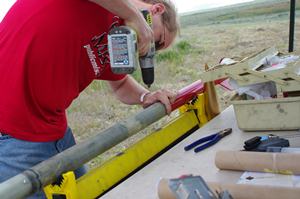 Special thanks to Washington Aerospace, the city of Mansfield, and all those who work as hard as they do to make this launch happen.
Special thanks to Washington Aerospace, the city of Mansfield, and all those who work as hard as they do to make this launch happen.
First up was a new 54mm minimum diameter project which I didnt have a name for yet. So it went by the monicker "no name" for the day. I had a few last minute tweaks, drilling holes for shear pins, etc.
The booster is actually something I put together years ago with the intention of being a sustainer in a 2 stage project. Never got around to finishing that, so I decided to just fly this as a discrete rocket.
Its all filament wound fiberglass, G10 fins, vacuum bagged fin can, etc. Very stout.
On the top half I used my now standard dual deployment technique that puts both drogue and main chute out the same end, but doesnt rely on a release device.
I acheieve this by 'stacking' the recovery components and ejection charges. Starting from the top of the rocket is the electronics bay, then a bulkhead with the terminals for the deployment charges.
In this particular rocket, a coupler serves as a 'sled' where the altmeter is mounted, the bulkhead goes on the end of that, and the entire assembly is slid down the top of the airframe and held in place by 2 screws that go through the outside of the airframe into threaded inserts in the bulkhead.
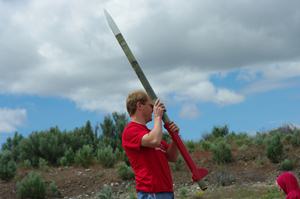 After the electronics sled and bulkhead is the main deployment charge, then the main chute (with a harness independant of the drogue), then the drogue chute and harness (which attaches to the booster) and finally the drogue deployment charge.
When the rocket reaches apogee, the drogue charge fires and separates the rocket into two pieces, pulling out the drogue harness. The main chute is still in the tube and remains there due to its being a snug fit. At 800 feet, the main charge fires and pushes out the main chute.
I've been using this approach in rockets from 54mm up to 6 inch diameter with great success. I find it simpler than using a release device.
After the electronics sled and bulkhead is the main deployment charge, then the main chute (with a harness independant of the drogue), then the drogue chute and harness (which attaches to the booster) and finally the drogue deployment charge.
When the rocket reaches apogee, the drogue charge fires and separates the rocket into two pieces, pulling out the drogue harness. The main chute is still in the tube and remains there due to its being a snug fit. At 800 feet, the main charge fires and pushes out the main chute.
I've been using this approach in rockets from 54mm up to 6 inch diameter with great success. I find it simpler than using a release device.
For the first flight today I loaded "No Name" with a Pro38 I540 5 grain reload. Altimeter was an ARTS 2, and I also had GPSFlight telemetry on board.
The Telemetry reports GPS location including altitude as well as barometric altitude every second. I lost Stratosphreak II last year because i didnt have any tracking on board.
I wasnt going to repeat that mistake this year. It always seems like when I have tracking on board the rocket lands in sight and it wasnt needed.
But as soon as I try to be lazy and fly without it, the rocket ends up miles away and is never recovered.
|
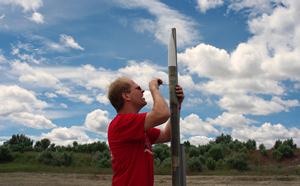
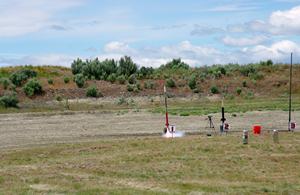
|
Once the rocket was on the rail and electronics armed, it was good to go. On liftoff there was a lot of 'wag', but it stayed pretty straight up. This wasnt a huge surprise as it was about 6 calibers overstable on the 38mm motor. The rocket is really geared towards larger 54mm motors.
I lost sight of the rocket after burnout, and telemetry dropped out as well. Not a good sign.
After a few tense moments I saw it drifting down under the main chute towards the road. Whew!
After recovery, I discovered that the telemetry battery had detached from the electronics at burnout.
I hadnt secured everything as well as I should have, but lucked out as it came in close enough to see. Good start to the day!
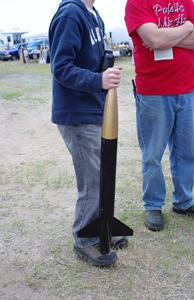 Next up was Cameron and his Public Missiles Bullpuppy. We built this rocket together a couple years ago, and its had a few good flights on it.
The canard fins have been removed as we got tired of gluing them back on after they fell off on what seems like every other flight. A common problem with this kit.
Next up was Cameron and his Public Missiles Bullpuppy. We built this rocket together a couple years ago, and its had a few good flights on it.
The canard fins have been removed as we got tired of gluing them back on after they fell off on what seems like every other flight. A common problem with this kit.
Cameron selected a Pro38 H100 motor for his first flight. Simulations had it hitting about 3000 feet. Cameron got the rocket prepped, motor loaded, and on the rail.
We reviewed what i consider 'best practice' when loading up a rocket on the rail. Get it on the rail, attach the ignitor to the leads before inserting it into the rocket, then put the ignitor in and check continuity.
Everything checked out and we retired to the flight line to watch the flight.
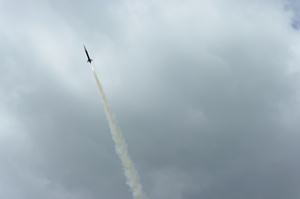 On liftoff the H100 pushed the Bullpuppy off the 4' rail quickly, but there was a little weathercocking into the wind as it cleared.
Besides that, the flight was good and it landed just a few hundred yards on the other side of the road, not far from where "No Name" had come down. Altitude was around 3500 feet.
On liftoff the H100 pushed the Bullpuppy off the 4' rail quickly, but there was a little weathercocking into the wind as it cleared.
Besides that, the flight was good and it landed just a few hundred yards on the other side of the road, not far from where "No Name" had come down. Altitude was around 3500 feet.
Two flights and Two successful recoveries.
Next, it was time to get my larger rocket, Hold The Mayo, off the ground. This was my level 3 certification project, from 9 (!) years ago.
A couple years back it suffered some damage when a motor CATO'd on the pad. I finished the rebuild / repair this winter and today was its first flight in some time.
The plan was to fly on an Aerotech 75mm M1550. This is a 3 second burn motor that does 300lbs of thrust with a red flame.
After finishing the prep, getting RSO signoff and a trip out to the away cell, my Dad helped me get HTM on the pad and ready for launch.
Once it was vertical I realized the arming screws were too high to reach and we didnt have a ladder.
Fortunately I had Cameron. He climbed on my shoulders and was able to arm the electronics from there.
The altimeters beeped out self check passed and the ignition leads were connected.
Queue the nerves!
I've had this rocket for a long time, and it has some sentimental value.
Its always a little weird taking something you're attached to and throwing it up in the sky and hoping it comes back down in one piece.
Hold The Mayo flies with redundant altimeters for parachute deployment, and ARTS2 and a PML Copilot.
I also had it loaded up with a GPSFlight telemetry unit reporting GPS location, altitude, and Barometric altitude every second.
The dual deployment setup is the same as 'No Name' above, with the drogue and main systems stacked in the same tube.
|
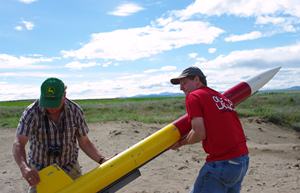
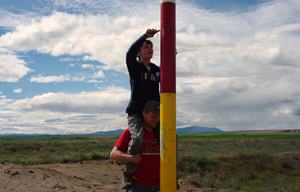
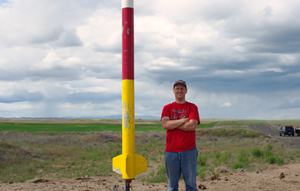
| |
The flight went well. Liftoff was near perfect, and it separated at apogee as expected.
The Telemetry worked flawlessly, reporting data through the boost and the entire flight all the way back to the ground.
This was good as I lost it in the sky after burnout. Watching the laptop i saw it pass 10,000 feet on its way back down under the drouge.
So far so good, as reported veritcal velocity was 50 feet per second, as expected under the drogue.
Cameron had it in the binoculars, so losing it in the sage wasnt a worry at this point.
I continued to watch the data stream as it passed below 6000 feet and lower until the main chute deployed.
Cameron heard the charges fire, but didnt see a main chute. The telemetry data didnt show the expected change in vertical velocity either. Not good!
Not much longer and it was on the ground. We could see it on the hillside, and I had GPS coordinates from the telemetry, so we were able to drive right to it.
|
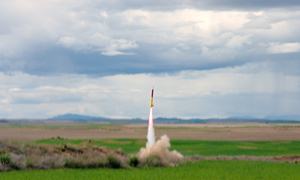
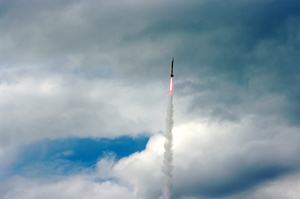
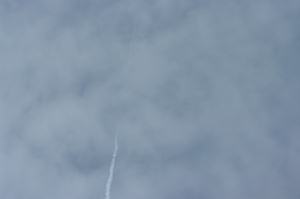
|
On our way there i was feeling quite anxious. Why hadnt the main chute deployed? I had ground tested the deployment charges, and we heard them fire, so what could have gone wrong?
And how much damage would i need to repair from the 100 MPH impact with the ground.
Once we arrived on the scene, i was pleasently surprised. No damage at all.
Its great when a falling rocket finds a soft spot to land in.
It turns out the chute did deploy, but the pilot chute on the main chute deployment bag tangled up in the main chute lines, and prevented it from coming out of the bag.
Lesson learned, and i'll be paying more attention to my parachute packing. I think i've learned this lesson before...
|
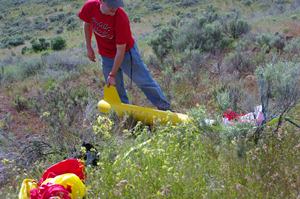
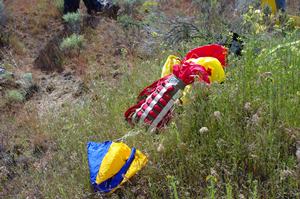
|
The flight data from the telmetry is plotted below. A great flight to 11,500 feet!
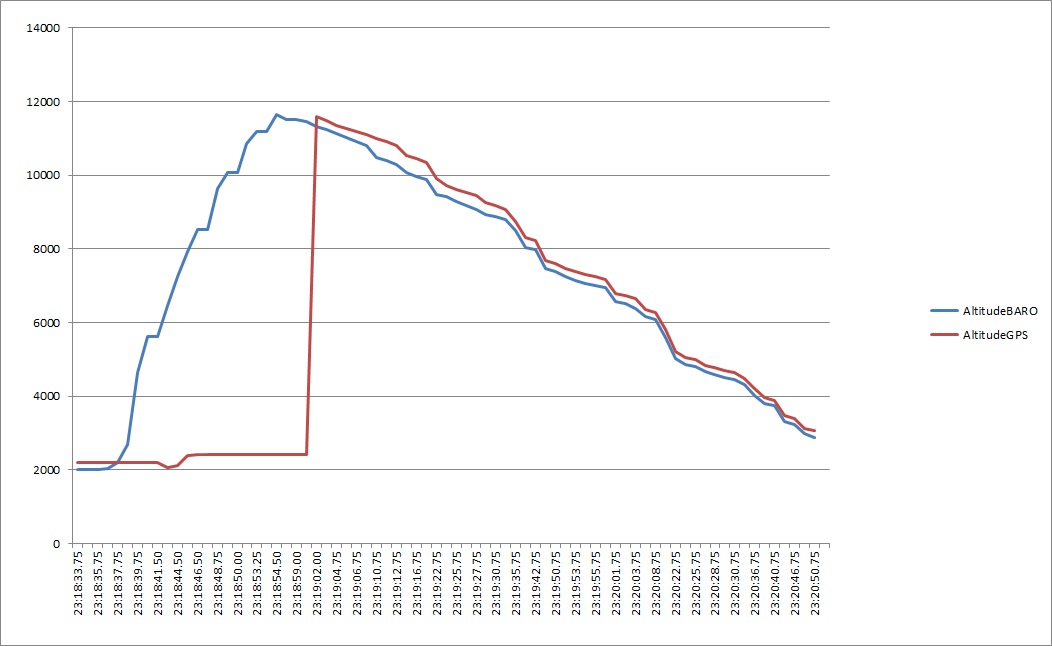
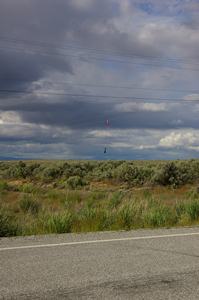 We finished the day on a bittersweet note. Cameron got another flight in on his Bullpuppy with a I212 to about 4500 feet.
Everything was perfect until it landed in the power lines.
This happens, and we have the local PUD lined up to retrieve the rocket off the lines. We'll have it back soon and it'll be ready to fly at the next launch!
We finished the day on a bittersweet note. Cameron got another flight in on his Bullpuppy with a I212 to about 4500 feet.
Everything was perfect until it landed in the power lines.
This happens, and we have the local PUD lined up to retrieve the rocket off the lines. We'll have it back soon and it'll be ready to fly at the next launch!
|
Back

Rocketry | Experimental | Webhosting | Email | Links | Home
Copyright 1998-2014 Greg Deputy - All Rights Reserved
|
|